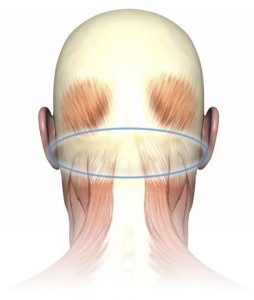Massage at the Top of the Spine
People who have suffered whiplash are a good number of the clients in massage therapists’ practices. They seek relief from neck and shoulder pain, tension headaches, migraines and fatigue.
Massage does wonders for sore muscles of the neck and shoulder even years after a whiplash. It opens fused muscles, improves circulation of blood and lymph, and helps muscles re-learn movement.
Usually people with whiplash have been around to many different doctors and therapists. Often they have gone as far as they can with them and have decided to try massage to reduce symptoms.
And here is where the massage therapist can shine. Depending on whether the whiplash was from the rear, front, sides or diagonal directions, massage can open up clogs of adhesed muscles and return their natural movement.
Most have thick fibrous bands starting at the occipital ridge and ligamentum nuchae, and simple Swedish strokes – softly drawing away from the occiput and gliding back – can draw down the congestion.
Light to medium trigger point work on taut bands of the trapezius, splenii, scm’s and scalenes will further restore motion.
What I find, however, is that many clients tell me massage therapists shy away from their  whiplash zones, even though this relatively simple work will bring much relief.
whiplash zones, even though this relatively simple work will bring much relief.
The whiplash survivor is not a china doll, but someone who needs the relief of massage.
Sometimes we are used to massaging the thick muscles of the shoulder area but clients start to cringe when we move up to the neck. It is a natural reflex to dig in to hardened tissue of the neck in order to loosen it. Actually, the opposite works much better. When I check the neck I soften my hands and do more soft molding strokes. I want the defenses to drop, not increase. When hands are soft, the tissue responds by allowing you to massage more deeply, but with gentleness.
Another common reflex is starting a stroke lightly and adding pressure as it proceeds. In effect, it is a grinding motion and a very unpleasant sensation to the client.
Instead, use the same medium pressure throughout the stroke. Go back and start the stroke again with slightly more pressure, repeating and adding slightly to the pressure with each glide, taking care not to depress the vertebrae. At the end of four to six strokes, the tissue will have been opened and drained. Success!
Drawing away from the congestion and doing light pressure techniques on the neck and upper shoulders will bring a great deal of relief without having to get into more complex techniques best left to intensive workshops. There is no reason to be afraid of making these areas worse. Your hands can’t go from 40 miles per hour to zero in one second!
A few who have had severe whiplash – and survived – they are the tough clients. Their symptoms are more serious – vertigo, sleep disruptions, fascia that forms nooses and restrictive loops over the years of compensating for severe imbalance.
I like to think I have great massage skills for all these folks, but I am cautious. Have neurologists or osteopaths with experience in these dysfunctions evaluated their injuries? Are they stuck or hyper-mobile? Have they had an increase in symptoms from additional injuries?
